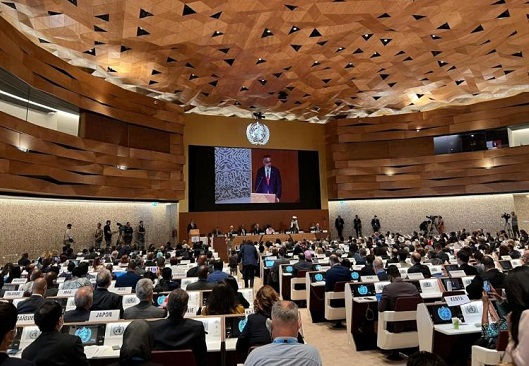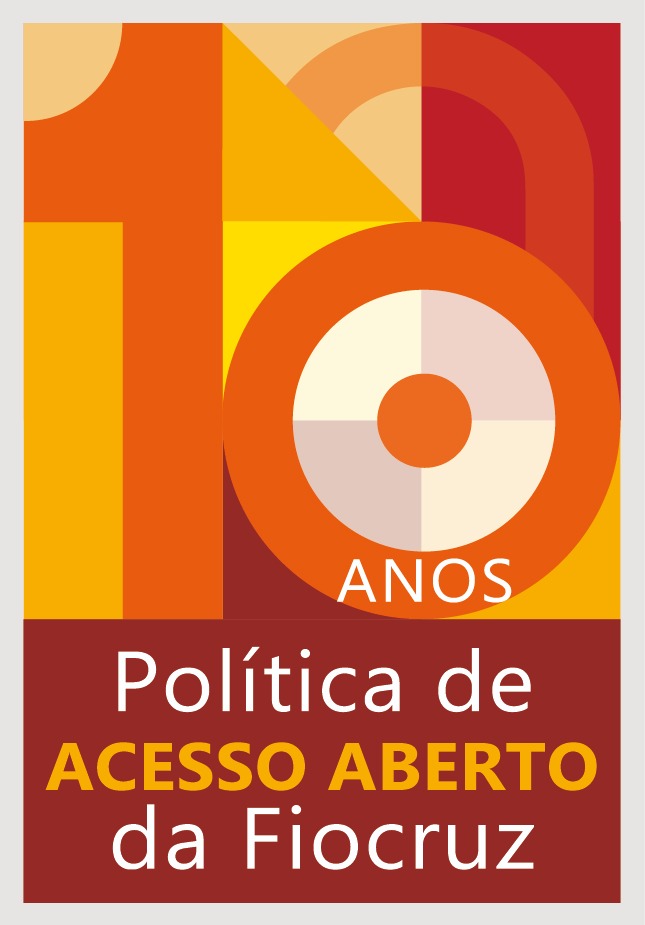Article: 75th World Health Assembly - Syndemic and political challenges for a multilateral agenda
08/06/2022
Paula Reges, Luana Bermudez, Luiz Augusto Galvão, Paulo Buss and Nísia Trindade Lima*
The Seventy-fifth World Health Assembly was held in Geneva, on 22-28 May 2022, with the theme "Health for peace, peace for health". For dozens of years, World Health Assemblies (WHAs) went unnoticed by the general public. However, since the emergence of the COVID-19 pandemic, they have been drawing the attention of politicians, diplomats and the civil society. Health has become an important part of the big policy. Not only because of the huge impact the pandemic had on all dimensions of life and the economy on a global level, but also for the increasing influence of the medical-industrial complex on the composition of GDPs, public budgets and people’s wallets as a whole.
The 75th WHA had the theme "Health for peace, peace for health" (image: WHO)
This year, in addition to these facts, which by themselves are enough to draw the attention of the entire world, the 75th Assembly renewed the mandate of the WHO (World Health Organization) director-general, Tedros Adhanom Ghebreyesus, for another five years. It was also the backdrop for demonstrations on the war (in Ukraine, and a little in all other wars). An examination of the Agenda of the 75th WHA, by itself, is already evidence that the WHO Secretariat and the ministries of health of its Member-States are well aware that we are not going through a COVID-19 pandemic, but a syndemic - caused by the pandemic. In fact, the list of themes discussed, in addition to intensely addressing the pandemic, also included a series of other topics of interest for global health, as the largest and unquestionable space for global health diplomacy.
The world’s ability to deal with multiple complexities has been amplified during the current pandemic. This means that the rhythm of decision-making has been intensified in order to keep up with constantly changing realities. At the opening, Dr. Tedros Adhanom highlighted the singular moment we are going through, “a convergence of disease, drought, famine and war, fueled by climate change, inequity and geopolitical rivalry”.
During the event, the importance of resuming face-to-face meetings was noted, as social interaction favors in-depth conversations, bilateral meetings, and exchanges of experiences and learning. It was also noted that even the normally austere rhythm of multilateral diplomatic decisions is now a little faster, which inevitably led to more confusion. The technical side collided with the political aspect, resulting in some collateral damage, including the fact that not all voices were heard, and civil society organizations participated less. In any case, decisions were made.
There were numerous singular moments during this WHA, with a historical return to in loco activities by the main body of global health governance. After a long recess, there were plenty of priority topics to discuss and pressing decisions to be made. Member-States naturally prioritized discussions on proposals to change global governance instruments, especially the negotiation process for a new treaty on the pandemic and a reform of the international sanitary regulation. Surveillance and control activities of emerging and reemerging diseases with pandemic potential, including the provision of supplies/consumables such as tests, vaccines and equipment, and the creation of integral health surveillance platforms, were all discussed. There was also room to discuss the contribution of global health to worldwide recovery and for the facing of worldwide challenges, such as peace and the climate crisis.
Member-States not only reelected Tedros Adhanom Ghebreyesus as director-general of the World Health Organization, but nations also committed to the WHO financial sustainability program. They also took a strong position against Russia, adopted a new resolution on clinical trials, and discussed the role played by the WHO in global health architecture, among many other areas of global health politics.
WHO took a decisive political position regarding Ukraine. The organization now has a greater responsibility for all current and future political conflicts, as critics infallibly point out, mentioning the examples of Palestine, Iraq and Syria, among others. The WHO has rarely been forced to take such a hard political position over three-quarters of a century of its existence. The organization has now likely set a precedent that it will not be able to leave behind easily.
The 75th WHA has become a cauldron of geopolitics, global sanitary safety, wars, and health emergencies. Alliances and rivalries among the positions taken by Member-States also occurred. Diplomats had conflicted opinions in several debates, such as the discussion to adopt the Global Strategy for HIV, Viral Hepatitis and Sexually Transmissible Infections 2022-2030.
The strategy was approved after socially conservative countries, spearheaded by Saudi Arabia and Egypt, strongly objected to the terms used in the strategy and in its attached glossary on sexual health and target populations for HIV treatment, a language that many specialists consider to be standard for this purpose. Speaking on behalf of the 22 WHO Member-States, the Regional Office for the Eastern Mediterranean (EMRO), with the support of a few African countries, the Saudi delegate and other EMRO nations, cataloged the terms they considered to be worthy of censuring, including references to sexuality, sexual orientation, and sexual rights. Objections were also raised to the reference, in the strategy, to “men who have sex with men”, as a target population for HIV treatment.
Although the final resolution containing these terms was eventually approved, the strategy led by EMRO delegates successfully weakened this important document and set a precedent for possible debates in the future, as only sixty Member States (one-third of the total) voted for it.
One of the most politically relevant decisions made at the Assembly was the adoption of recommendations, based on the Final Report of the sustainable finance working group. There was much fuss in the process, marking this decision as a moment that, to some extent, strengthens WHO funding. Support was expressed for the recommendations, including the proposal to gradually increase fixed contributions, with the goal of having them cover 50% of the base budget approved for the 2022-2023 period, up to the 2030-2031 period. However, semantic issues regarding the use of the word “to aspire” indicate that Member-States are not empowered to present this proposal.
The follow-up of the Political declaration of the third high-level meeting of the General Assembly on the prevention and control of non-communicable diseases resulted in 13 annexes to the main document, with a presentation of global strategies to be implemented regarding the different dimensions of this set of infirmities: 2023-2030 script for the implementation of the global action plan to prevent and control of non-communicable diseases (NCDs); policies to build resilience of health systems and to treat people with non-communicable diseases and to prevent and control their risk factors in humanitarian emergencies; intersectoral global action plan on epilepsy and other neurological conditions 2022-2031; plan for the prevention and management of obesity during one’s lifetime; global strategy to eliminate cervical cancer as a public health issue; intersectoral global action plan on oral health; and, finally, the preparation process for the 2025 high-level meeting of the General Assembly on the prevention and control of non-communicable diseases.
The theme of Human resources for health was the subject of several discussions, which included the 2022-2030 action plan Working for Health; the Global Pact for Health Professionals and Caregivers; the WHO Global Code of Practices for the International Recruitment of Healthcare Personnel; and the Global Strategy of Human Resources for Health: 2030 Health Workforce.
As mentioned above, the development that drives the plans for preparation, strengthening and response to health emergencies echoed several of the discussions. The preparation for the next pandemic will demand more than a commitment made by the delegates at the Assembly. It will require a structural change towards a fairer configuration of global health, in which power is distributed in a more equitable manner, by means of a model of social businesses to produce vaccines and drugs. At the WHA, the report of the Independent Oversight and Advisory Committee for the WHO Health Emergencies Program was adopted, addressed to the Director-General, dealing on the issue of public health emergencies, including the preparation-and-response duo.
Fiocruz’s participation in the WHA included crucial messages from the Foundation, such as an emphasis on the importance of science, technology and innovation, with the need for permanent investments, as opposed to investments made only in health emergencies. It is through a better structured, supporting foundation that the ability to provide rapid responses to the crisis is formed, and this has an impact on the possibility to save lives.
Strengthening the local production of supplies/consumables and the development of technologies is a key factor for technological autonomy, a crucial aspect that must be seen as part of health systems and strategies for their strengthening. In the Brazilian perspective, it emphasizes the importance of strengthening the Unified Health System (SUS). Fiocruz’s participation in the PAHO/WHO program of technology transfer hubs regarding mRNA vaccines for the development, production, supply and technology transfer in Latin America is a further confirmation of our commitment to establishing a local production arrangement and preparing for future emergencies.
The main message is that technological autonomy must always be directed to promote equity in access to health innovations, with implications on response times and on the number of lives saved. Inequality in access is the most profound expression of the negative impact of restriction of basic items in the fight against critical conditions.
Fiocruz is therefore acknowledged as an institution that acts in multiple spheres, an important global actor with a collaborative and strategic capacity to strengthen health systems and to support the reduction of iniquity all over the world.
* Paula Reges and Luana Bermudez are researchers of the Fiocruz Global Health Centre (Cris/Fiocruz); Luiz Augusto Galvão is a senior researcher of Cris/Fiocruz; Paulo Buss is the coordinator of Cris/Fiocruz; Nísia Trindade Lima is the president of Fiocruz.
** This article was originally published at Strategic Studies Centre's (CEE/Fiocruz) site in Portuguese.





